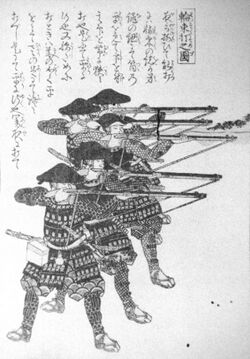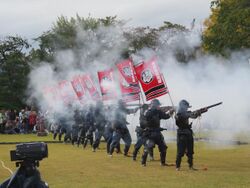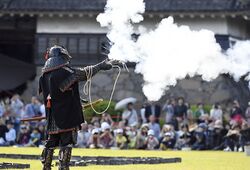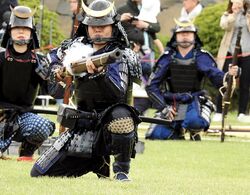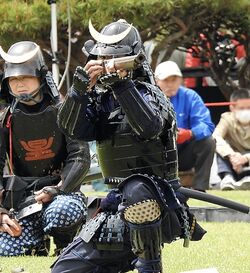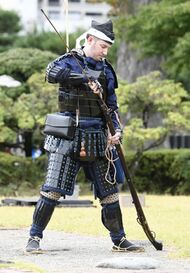Engineering:Tanegashima (gun)
Tanegashima (種子島), most often called in Japanese and sometimes in English Lua error in Module:Lang/utilities at line 268: attempt to call field '_transl' (a nil value)., was a type of matchlock-configured[1] arquebus[2] firearm introduced to Japan through the Portuguese Empire in 1543.[3] It was used by the samurai class and their Script error: The function "transl" does not exist. "foot soldiers", and within a few years its introduction in battle changed the way war was fought in Japan forever.[4] It, however, could not completely replace the Script error: The function "transl" does not exist. (longbow). Although the Japanese developed various techniques to improve the gun's shortcomings, specifically its slow rate of fire and inability to fire in the rain,[5][6][7] it remained inferior to the Script error: The function "transl" does not exist. in these respects, and the latter continued to be an important weapon on the battlefield.[8][9] After Tokugawa Ieyasu destroyed the Toyotomi clan in the siege of Osaka and established the Tokugawa shogunate, the relatively peaceful Edo period arrived, and the use of Script error: The function "transl" does not exist. declined.
History
Origins
Sengoku period
Much of Japan was involved with internecine wars during the Sengoku period (1467–1603), as feudal lords vied for supremacy.[10] Matchlock guns were introduced midway through the period and saw extensive use in the later years of the conflict, playing a decisive role on the battlefield. In 1549, Oda Nobunaga ordered 500 guns to be produced for his armies at a time when the benefits of firearms over traditional weapons were still relatively questionable to other Script error: The function "transl" does not exist.. However the new firearm had undoubted advantages in range in comparison with traditional bows. In addition, bullets could penetrate almost any armor and shield.[11] Joseon official Ryu Seong-ryong quoted:
In the 1592 invasion, everything was swept away. Within a fortnight or a month the cities and fortresses were lost, and everything in the eight directions had crumbled. Although it was [partly] due to there having been a century of peace and the people not being familiar with warfare that this happened, it was really because the Japanese had the use of muskets that could reach beyond several hundred paces, that always pierced what they struck, that came like the wind and the hail, and with which bows and arrows could not compare.[12]
But a significant drawback was the high price of each musket and the long production time. Ryu Seong-ryong:
However, the musket is a very intricate instrument, and very difficult to produce. The Script error: The function "transl" does not exist. [written by Qi Jiguang in 1560] says one month for boring the barrel is optimal—that is, one musket takes the labor of one person for one month before it is ready for use. The difficulty and expense are like that. In recent days, the muskets used by the supervisorate have all been captured Japanese weapons. There are not many and they frequently burst, becoming fewer by the day.[12]
The Japanese soon worked on various techniques to improve the effectiveness of their guns. They developed a staggered firing technique to create a continuous rain of bullets on the enemy.[5] They also developed larger caliber barrels and ammunition to increase lethality.[5] Protective boxes in lacquerware were invented to fit over the firing mechanism so it could still fire while it was raining,[6] as were systems to accurately fire weapons at night by keeping fixed angles thanks to measured strings.[13] Another development would be the Script error: The function "transl" does not exist., a bamboo cartridge used to facilitate faster reloading.[7] A hollow tube open at both ends, the Script error: The function "transl" does not exist. contained gunpowder, wadding, and a bullet. Upon tearing open the tube's paper seal at the bottom, a soldier could quickly use it to pour the necessary powder into his weapon before placing over the barrel and using his rammer to load both wadding and bullet into the barrel at the same time. After use, the Script error: The function "transl" does not exist. could be kept for repacking or discarded.[7]
In 1563 the Amago clan of Izumo Province won a victory over the Kikkawa clan with 33 of their adversaries wounded by Script error: The function "transl" does not exist..[14] In 1567, Takeda Shingen announced that, "Hereafter, the guns will be the most important arms, therefore decrease the number of spears per unit, and have your most capable men carry guns".[15] Oda Nobunaga used tanegashima in the Battle of Anegawa (1570), and again against the powerful Takeda clan in the Battle of Nagashino (1575), 3,000 gunners helped win the battle, firing by volleys of a thousand at a time. They were concealed across a river and used breastworks to effectively stop enemy infantry and cavalry charges while being protected.[16] The defeat of the powerful Takeda clan brought about permanent changes in battle tactics. In the Battle of Numajiri (1584), Satake Yoshishige won against Hojo clan, due in part to the use of over 8600 matchlock rifles by their troops.[17]
Japan became so enthusiastic about the new weapons that it possibly overtook every European country in absolute numbers produced.[18] Japan also used the guns in the Japanese invasion of Korea in 1592, in which about a quarter of the invasion force of 160,000 were gunners.[19] They were extremely successful at first and managed to capture Seoul just 18 days after their landing at Busan.[20]
Edo period
The internal war for control of Japan was won by Tokugawa Ieyasu, who defeated his rivals at the Battle of Sekigahara in October 1600. Three years later, he established the Tokugawa shogunate, a powerful entity that would maintain peace, stability, and prosperity in Japan for the following 250 years. This is known as the Edo period (1603–1868). From the mid-17th century, Japan decided to close itself to interaction with the West except for the Dutch Republic through its policy of Script error: The function "transl" does not exist.. Contrary to popular belief, this did not lead to Japan "giving up the gun"; if anything, the gun was used less frequently because the Edo period did not have many large-scale conflicts in which a gun would be of use. Often the katana was simply the more practical weapon in the average small-scale conflicts.
Isolation did not eliminate the production of guns in Japan—on the contrary, there is evidence of around 200 gunsmiths in Japan by the end of the Edo period.[21] However, the social life of firearms had changed: as the historian David L. Howell has argued, for many in Japanese society, the gun had become less a weapon than a farm implement for scaring off animals.[22] With no external enemies for over 200 years, Script error: The function "transl" does not exist. were mainly used by samurai for hunting and target practice, the majority were relegated to the arms store houses of the Script error: The function "transl" does not exist..
The arrival in Japan of the United States Navy led by Matthew C. Perry in 1854 started a period of rearmament. The Script error: The function "transl" does not exist. was an antiquated weapon by the 1800s and various samurai factions acquired advanced firearms including the minié rifle, breech-loading and repeating rifles. The samurai era ended in 1868 with the Meiji period; Japan turned to a national conscription army with modern weapons and uniforms. Some gunsmiths did replace their matchlock-type Script error: The function "transl" does not exist. into percussion cap mechanisms while retaining its design as a musket. The last use of samurai armour and traditional weapons in Japan, including Script error: The function "transl" does not exist., was during the Satsuma Rebellion (1877), when the Meiji government's newly established Imperial Japanese Army put an end to the last samurai and their resistance to modernization.[citation needed]
Classifications of different guns
Japanese arquebuses are classified by the location of their native gunsmiths as well as with the weight of the ball by momme.
Script error: The function "transl" does not exist. (numbered cylinder)
The most common users of the Script error: The function "transl" does not exist. were peasant foot soldiers commanded by the samurai, the Script error: The function "transl" does not exist.. Where warfare changed during the Sengoku era exponentially with massed pike, archer, and eventually arquebus formations, large quantities of guns were needed and produced to equip the Script error: The function "transl" does not exist. (gun units) of the feudal Japanese armies.
As these guns were primarily used by the Script error: The function "transl" does not exist., they were of low quality and were stored in arsenals where they could be used again.
Script error: The function "transl" does not exist. (small cylinder)
Script error: The function "transl" does not exist. were generally matchlock pistols that due to their inferior range and firepower compared to the Script error: The function "transl" does not exist., were not best suited in open field battles and were instead used as status symbols for mounted samurai. They were occasionally used for self-defense by high ranking commanders.
Script error: The function "transl" does not exist. (middle cylinder)
At the advent of firearms, Japanese armies had to come up with reliable ways of repelling the widespread use of guns; whether it would be the creation of metal and soon bullet-proof armor, standing bamboo bundles tied together or heavy iron pavises. With the caliber of the Script error: The function "transl" does not exist. being too weak to penetrate these protection methods, a new, yet harder to handle and expensive gun with a larger gun caliber was needed to equip the Script error: The function "transl" does not exist. formations that encountered these obstacles; the Script error: The function "transl" does not exist. was such a solution.
Script error: The function "transl" does not exist. (great cylinder)
Guns of the Script error: The function "transl" does not exist. caliber (20 momme (≈ 75 g (2.6 oz)) and more) were practically portable hand cannons and were used as siege weapons employed to knock down the hinges of gates as well as powerful anti-personnel and anti-cavalry weapons.
A gun of this size was typically hard to operate (though varying on the momme), requiring plentiful amounts of gunpowder and proper training. One of the issues of operating such device was the powerful recoil and the difficulty of transporting, where sometimes larger Script error: The function "transl" does not exist. were either rested on rice bales, hung from trees using ropes, or installed on a carriage (similar to European cannons).
Samurai-Script error: The function "transl" does not exist. (samurai cylinder)
The samurai-Script error: The function "transl" does not exist. guns were custom-made for use only by the samurai, whose high social standing and wealth meant they could afford well-crafted and intricately designed guns which were longer and of larger caliber, as opposed to the cruder and inferior quality Script error: The function "transl" does not exist. used by the Script error: The function "transl" does not exist..
Script error: The function "transl" does not exist. (loop hole/hole cylinder)
Script error: The function "transl" does not exist. or Script error: The function "transl" does not exist. guns were generally longer than most guns and had a smaller caliber than even the Script error: The function "transl" does not exist.. These guns were used on castles and ships primarily as long range defensive weapons.
Script error: The function "transl" does not exist. (horse riding cylinder)
As the Script error: The function "transl" does not exist. became a status symbol among the Script error: The function "transl" does not exist. (cavalry), it eventually made its way into becoming a cavalry gun. These guns were similar in structure to the Script error: The function "transl" does not exist., but had a longer barrel and were fairly easy to reload on horseback.
Script error: The function "transl" does not exist. (target cylinder)
Script error: The function "transl" does not exist. were made purely for the purpose of target practice.
Modern use
Today Script error: The function "transl" does not exist. are readily available from sellers of antique firearms and dealers of samurai antiques both in Japan and the West. Modern Script error: The function "transl" does not exist. gun troops in Japan re-enact the use of Script error: The function "transl" does not exist. in battle, and black powder enthusiasts use Script error: The function "transl" does not exist. for target practice.[23]
Parts
- Script error: The function "transl" does not exist. – Butt protector
- Script error: The function "transl" does not exist. – Trigger
- Script error: The function "transl" does not exist. – Lock
- Script error: The function "transl" does not exist. – Plate
- Script error: The function "transl" does not exist. – Trigger guard
- Script error: The function "transl" does not exist. – Rivet
- Script error: The function "transl" does not exist. – Hole for the matchcord
- Script error: The function "transl" does not exist. – Spring
- Script error: The function "transl" does not exist. – Stock ring
- Script error: The function "transl" does not exist. – Hammer arm
- Script error: The function "transl" does not exist. – Barrel protector
- Script error: The function "transl" does not exist. – Pancover
- Script error: The function "transl" does not exist. – Pantray
- Script error: The function "transl" does not exist. – Stock
- Script error: The function "transl" does not exist. – Barrel
- Script error: The function "transl" does not exist. – Rear sight
- Script error: The function "transl" does not exist. – Sling hole
- Script error: The function "transl" does not exist. – Middle sight
- Script error: The function "transl" does not exist. – Pin hole
- Script error: The function "transl" does not exist. – Front sight
- Script error: The function "transl" does not exist. – Ramrod
- Script error: The function "transl" does not exist. – Muzzle
Gallery
See also
- Nanban trade period
- Java arquebus
- Istinggar
- Jiaozhi arquebus
References
- ↑ East Asia: A Cultural, Social, and Political History, Authors Patricia Ebrey, Anne Walthall, James Palais, Publisher Cengage Learning, 2008, ISBN:978-0-547-00534-8 P257
- ↑ Lidin, Olof G. (2002). Tanegashima: the arrival of Europe in Japan. NIAS Press. p. 4. ISBN 978-87-91114-12-0. https://books.google.com/books?id=6WQnNqhDNhAC&pg=PA4.
- ↑ Tanegashima: the arrival of Europe in Japan, Olof G. Lidin, Nordic Institute of Asian Studies, NIAS Press, 2002 P.1-14
- ↑ Noel Perrin (1979). Giving up the gun: Japan's reversion to the sword, 1543-1879. David R Godine. ISBN 9780879237738. https://archive.org/details/givingupgun00noel. Retrieved 2011-09-22.
- ↑ 5.0 5.1 5.2 Perrin p.17
- ↑ 6.0 6.1 Perrin, p.18
- ↑ 7.0 7.1 7.2 Wayland, Dean. "TEPPŌ Japanese Matchlock Guns". http://www.thefightschool.demon.co.uk/SHOGUN_Articles_TEPPOU.htm.
- ↑ "Error: no
|title=specified when using {{Cite web}}" (in ja). Nagoya Japanese Sword Museum Nagoya Touken World. https://www.touken-world.jp/tips/39107/. - ↑ "Error: no
|title=specified when using {{Cite web}}" (in ja). Nagoya Japanese Sword Museum Nagoya Touken World. https://www.touken-world.jp/tips/65943/. - ↑ Perrin p.9
- ↑ Andrade, Tonio. (2016) The Gunpowder Age p. 184: "When [our] soldiers are lined up against the enemy ranks, our arrows do not reach the enemy while their musket balls rain down upon us."
- ↑ 12.0 12.1 Firearms: A Global History to 1700 by Kenneth Chase
- ↑ Perrin, p.40
- ↑ Ferejohn, John A.; Rosenbluth, Frances McCall (2010). War and State Building in Medieval Japan. Stanford University Press. p. 147. ISBN 978-0-8047-7431-4. https://books.google.com/books?id=YPkYMoO0ycIC&pg=PA147.
- ↑ Perrin, p.17
- ↑ Perrin p.19-20
- ↑ name="Satake-Shi at harimaya.com"
- ↑ Perrin p.25
- ↑ Perrin p.27
- ↑ Perrin p.28
- ↑ Samurai Archives Podcast EP05 "The Myth of Samurai Giving Up the Gun". Retrieved August 13, 2013.
- ↑ Howell, David L. (1 May 2009). "The Social Life of Firearms in Tokugawa Japan". Japanese Studies 29 (1): 65–80. doi:10.1080/10371390902780530.
- ↑ "Home". http://www.gunsamurai.com/.
Further reading
- Tanegashima: the arrival of Europe in Japan, Olof G. Lidin, Nordic Institute of Asian Studies, NIAS Press, 2002
- The bewitched gun : the introduction of the firearm in the Far East by the Portuguese, by Rainer Daehnhardt 1994 ISBN:978-972-47-0373-2
- The Japanese matchlock (in English), color printing, 60 pages, Shigeo Sugawa
- Giving up the gun: Japan's reversion to the sword, 1543-1879, Noel Perrin, David R. Godine Publisher, 1979
External links
- The varieties of Japanese matchlock (Script error: The function "transl" does not exist.).
- Script error: The function "transl" does not exist. information.
- Script error: The function "transl" does not exist. accessories
- Parts of the Script error: The function "transl" does not exist.
- Matsumoto Castle Gun Corps
- (in Japanese) "Satake-shi" on Harimaya.com (accessed 15 August 2008)
 |
